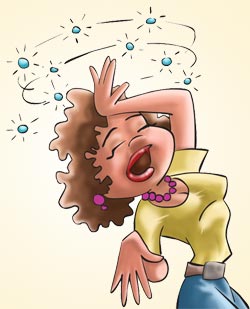
We can all think back to countless movies we’ve seen in which one of the character in the movie faints – often in a funny way. Think of the Cowardly Lion in The Wizard of Oz, and Linus in It’s The Great Pumpkin, Charlie Brown. We may think that it's very amusing and entertaining to watch someone up on the silver screen faint, but it’s often rather scary to witness a real, live faint, especially if it involves a loved one. Often, the fainter turns white as a ghost or ashen grey, their eyes glaze over or even roll back, and then their whole body goes limp. Sometimes it almost seems like the person has died, though (thankfully) within a few seconds to a minute or two the victim of a fainting spell comes around and seems to be back to normal within a short time. Fainting can be even more scary if it happens to you. This article was written to help you understand what causes fainting and what can be done to diagnose and treat this unpredictable condition.
Fainting, also known as syncope (pronounced SINK-o-pee), is a rather common symptom that affects up to 20% of normal people at some point in their life. Approximately 2-4% of all hospital admissions are for the evaluation of syncope, and over $800 million are spent on diagnosing patients with this symptom each year. Fainting, also known as “passing out” or “blacking out,” can occur in any one at nearly any age, and is defined as a sudden loss of consciousness associated with the muscles of the body becoming limp. An old fashioned name for fainting is “swooning.”
Often, the person with syncope knew something was wrong beforehand – they had warning symptoms or a “prodrome” prior to passing out. The prodrome can be a feeling of lightheadedness or dizziness, feeling “hot,” nauseated, weak, or sweaty. Some people describe a “draining” feeling just before they lose consciousness. The loss of muscle tone causes a person to slide or fall to the floor, or if they are sitting they will slump over. Injury occurs commonly, and emergency rooms are full of people with bumps, bruises, and broken bones due to syncope. Serious injury (like a skull fracture or a broken hip) is a worrisome part of syncope, so a fainting spell should never be ignored. Having a fainting condition can affect a person's ability to drive or to work, and can impact significantly on the quality of life of the fainter and their family. Sometimes fainting can be a sign of a serious, even life-theatening condition, especially in patients who already have a history of heart disease. Anyone who faints should be evaluated by a physician trained to assess the cause of syncope and determine the best way to manage the problem.


